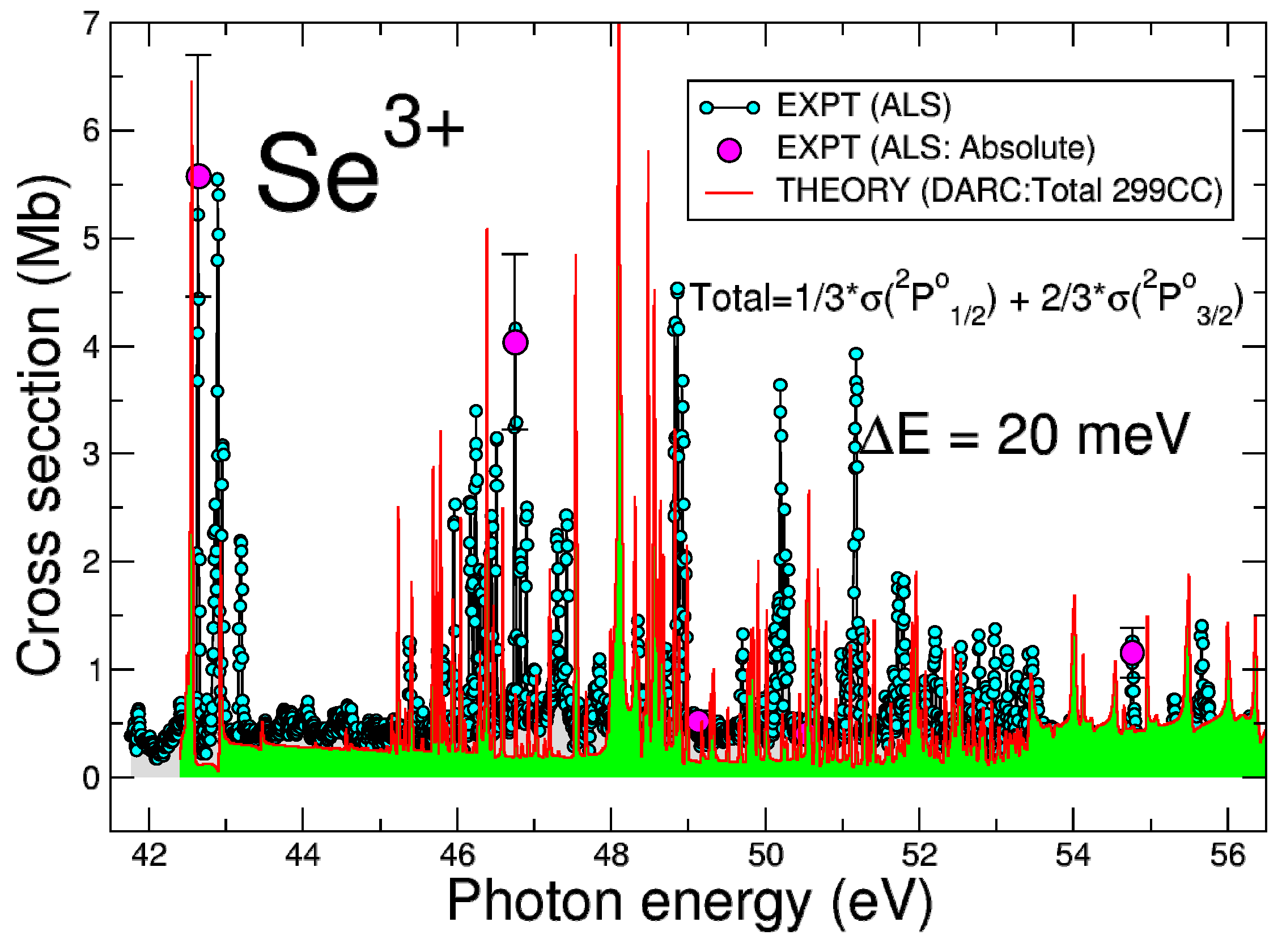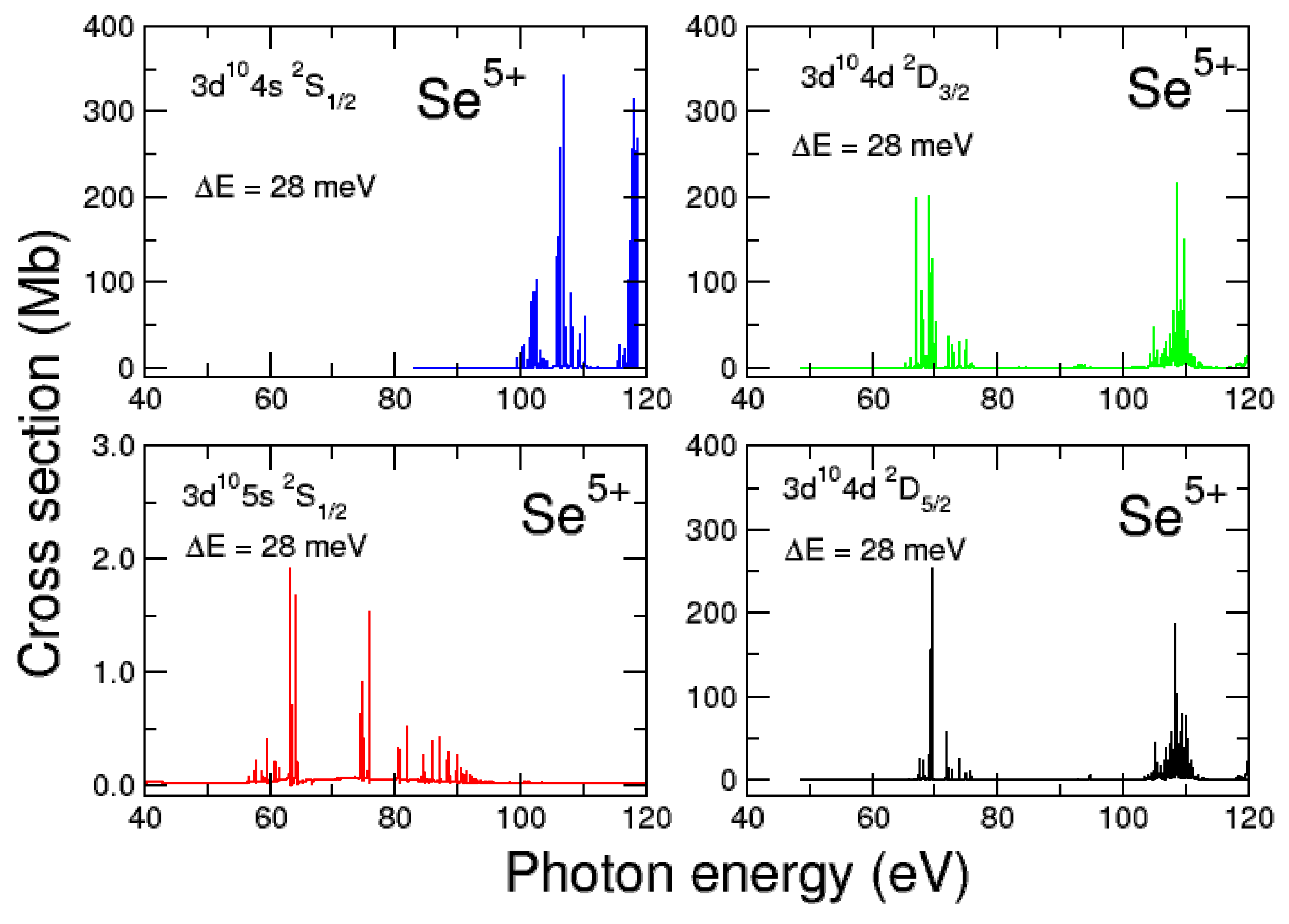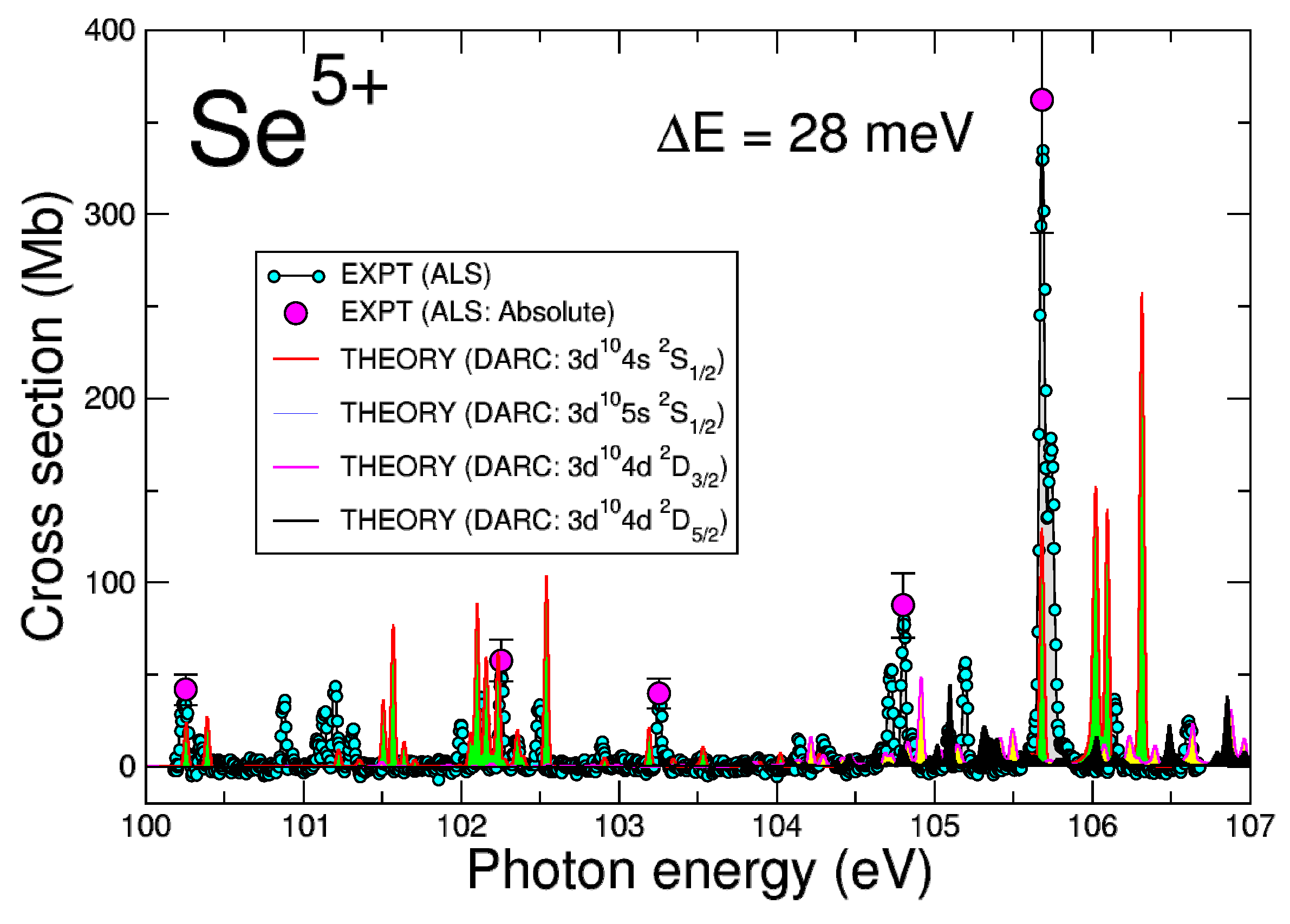Photoionization of Trans-Fe Ions: Se IV, Se V, and Se VI
Abstract
1. Introduction
2. Photoionization
2.1. Se IV
2.2. Se V
2.3. Se VI
3. Comparison of Theory and Experiment
4. Conclusions
5. Summary
Author Contributions
Funding
Data Availability Statement
Acknowledgments
Conflicts of Interest
References
- Chayer, P.; Vennes, S.; Dupuis, J.; Kruk, J.W. Abundance of Elements beyond the Iron Group in Cool DO White Dwarfs. Astrophys. J. 2005, 630, L169. [Google Scholar] [CrossRef]
- Werner, K.; Rauch, T.; Ringat, E.; Kruk, J.W. First detection of krypton and xenon in a white dwarf. Astrophys. J. 2012, 753, L7. [Google Scholar] [CrossRef]
- Rauch, T.; Quinet, P.; Knörzer, M.; Hoyer, D.; Werner, K.; Kruk, J.W.; Demleitner, M. Stellar laboratories: IX. New Se v, Sr iv-vii, Te vi, and I vi oscillator strengths and the Se, Sr, Te, and I abundances in the hot white dwarfs G191-B2B and RE 0503-289. Astron. Astrophys. 2017, 606, A105. [Google Scholar] [CrossRef]
- Dorsch, M.; Latour, M.; Heber, U.; Irrgang, A.; Charpinet, S.; Jeffery, C.S. Heavy-metal enrichment of intermediate He-sdOB stars: The pulsators Feige 46 and LS IV-14°116 revisited. Astron. Astrophys. 2020, 643, A22. [Google Scholar] [CrossRef]
- Roederer, I.U. Germanium, Arsenic, and Selenium Abundances in Metal-poor Stars. Astrophys. J. 2012, 758, 36. [Google Scholar]
- Roederer, I.U.; Schatz, H.; Lawler, J.E.; Beers, T.C.; Cowan, J.J.; Frebel, A.; Ivans, I.I.; Sneden, C.; Sobeck, J.S. New Detections of Arsenic, Selenium, and Other Heavy Elements in Two Metal-poor Stars. Astrophys. J. 2014, 791, 32. [Google Scholar]
- Sterling, N.C.; Dinerstein, H.L. The Abundances of Light Neutron-Capture Elements in Planetary Nebulae. II. s-Process Enrichments and Interpretation. Astrophys. J. Suppl. Ser. 2008, 174, 158. [Google Scholar]
- García-Rojas, J.; Madonna, S.; Luridiana, V.; Sterling, N.C.; Morisset, C.; Delgado-Inglada, G.; Toribio San Cipriano, L. s-process enrichment in the planetary nebula NGC 3918. Results from deep echelle spectrophotometry. Mon. Not. R. Astron. Soc. 2015, 452, 2606. [Google Scholar]
- Sterling, N.C.; Dinerstein, H.L.; Kallman, T.R. The Abundances of Light Neutron-Capture Elements in Planetary Nebulae. I. Photoionization Modeling and Ionization Corrections. Astrophys. J. Suppl. Ser. 2007, 169, 37. [Google Scholar]
- Sterling, N.C.; Porter, R.L.; Dinerstein, H.L. The Abundances of Light Neutron-capture Elements in Planetary Nebulae. III. The Impact of New Atomic Data on Nebular Selenium and Krypton Abundance Determinations. Astrophys. J. Suppl. Ser. 2015, 218, 25. [Google Scholar] [CrossRef]
- Träbert, E.; Santana, J.A.; Quinet, P.; Palmeri, P. Intercombination Transitions in the n = 4 Shell of Zn-, Ga-, and Ge-Like Ions of Elements Kr through Xe. Atoms 2018, 6, 40. [Google Scholar] [CrossRef]
- Rauch, T.; Deetjen, J.L. Handling of Atomic Data. arXiv 2003, arXiv:astro-ph/0403239. [Google Scholar]
- Rauch, T.; Quinet, P.; Hoyer, D.; Werner, K.; Richter, P.; Kruk, J.W.; Demleitner, M. Stellar laboratories. VII. New Kr iv–vii oscillator strengths and an improved spectral analysis of the hot, hydrogen-deficient DO-type white dwarf RE 0503-289. Astron. Astrophys. 2016, 590, A128. [Google Scholar] [CrossRef]
- McLaughlin, B.M.; Ballance, C.P. Photoionization cross section calculations for the halogen-like ions Kr+, Xe+. J. Phys. B. At. Mol. Opt. Phys. 2012, 45, 085701. [Google Scholar] [CrossRef]
- Macaluso, D.A.; Aguilar, A.; Kilcoyne, A.L.D.; Red, E.C.; Bilodeau, R.C.; Phaneuf, R.A.; Sterling, N.C.; McLaughlin, B.M. Absolute single photoionization of Se2+: Experiment and Theory. Phys. Rev. A 2015, 92, 063424. [Google Scholar]
- Esteves, D.A.; Bilodeau, R.C.; Phaneuf, R.A.; Kilcoyne, A.L.D.; Red, E.C.; Aguilar, A. Absolute single photoionization cross-section measurements of Se3+ and Se5+. J. Phys. B At. Mol. Opt. Phys 2012, 45, 115201. [Google Scholar]
- McLaughlin, B.M.; Ballance, C.P.; Pindzola, M.S.; Stancil, P.C.; Babb, J.F.; Schippers, S.; Müller, A. PAMOP2: Towards Exascale Computations Supporting Experiments and Astrophysics. In High Performance Computing in Science and Engineering’18; Nagel, W.E., Kröner, D.H., Resch, M.M., Eds.; Springer: Berlin, Germany, 2019; pp. 37–61. [Google Scholar]
- Ballance, C.P. DARC Codes Website. Available online: http://connorb.freeshell.org (accessed on 3 April 2025).
- Grant, I.P. Quantum Theory of Atoms and Molecules: Theory and Computation; Springer: New York, NY, USA, 2007. [Google Scholar]
- Burke, P.G. R-Matrix Theory of Atomic Collisions: Application to Atomic, Molecular and Optical Processes; Springer: New York, NY, USA, 2011. [Google Scholar]
- Dyall, K.G.; Johnson, C.T.; Grant, I.P.; Parpia, F.; Plummer, E.P. GRASP: A general-purpose relativistic atomic structure program. Comput. Phys. Commun. 1989, 55, 425. [Google Scholar]
- Parpia, F.; Froese-Fisher, C.; Grant, I.P. GRASP92: A package for large-scale relativistic atomic structure calculations. Comput. Phys. Commun. 2006, 94, 249. [Google Scholar]
- Kramida, A.E.; Ralchenko, Y.; Reader, J.; NIST ASD Team. NIST Atomic Spectra Database (Version 5.6.1); National Institute of Standards, Technology: Gaithersburg, MD, USA, 2018. [Google Scholar]
- Chen, M.H.; Cheng, K.T. A large-scale relativistic configuration-interaction approach: Application to the 4s2-4s4p transition energies and E1 rates for Zn-like ions. J. Phys. B At. Mol. Opt. Phys. 2010, 43, 074019. [Google Scholar] [CrossRef]
- Churilov, S.S.; Joshi, Y.N. Analysis of the strongly interacting 4s4f, 4p4d and 4p5s configurations of Se V and Br VI. Phys. Scr. 1995, 51, 196–203. [Google Scholar] [CrossRef]
- Kim, Y.K.; Baik, D.H.; Indelicato, P.; Desclaux, J.P. Resonance transition energies of Li-, Na-, and Cu-like ions. Phys. Rev. A 1991, 44, 148–166. [Google Scholar] [CrossRef] [PubMed]
- Müller, A.; Phaneuf, R.A.; Aguilar, A.; Gharaibeh, M.F.; Schlachter, A.S.; Alvarez, I.; Cisneros, C.; Hinojosa, G.; McLaughlin, B.M. Photoionization of C2+ ions: Time-reversed recombination of C3+ with electrons. J. Phys. B At. Mol. Opt. Phys. 2002, 35, L137. [Google Scholar] [CrossRef]
- Schippers, S.; Müller, A.; McLaughlin, B.M.; Aguilar, A.; Cisneros, C.; Emmons, E.D.; Gharaibeh, M.F.; Phaneuf, R.A. Photoionization studies of the B+ valence shell: Experiment and theory. J. Phys. B At. Mol. Opt. Phys. 2003, 36, 3371. [Google Scholar] [CrossRef]
- Müller, A.; Schippers, S.; Phaneuf, R.A.; Kilcoyne, A.L.D.; Bräuning, H.; Schlachter, A.S.; Lu, M.; McLaughlin, B.M. State-resolved valence shell photoionization of Be-like ions: Experiment and theory. J. Phys. B At. Mol. Opt. Phys. 2010, 43, 225201. [Google Scholar] [CrossRef]
- Van Kleef, T.A.M.; Joshi, Y.N. Extended analyses of Se vii and Se viii. J. Opt. Soc. Am. B 1984, 1, 271–278. [Google Scholar] [CrossRef]
- Ryabtsev, A.N.; Wyart, J.F.; van Kleef, T.A.M.; Joshi, Y.N. Observation of Autoionizing Energy Levels in the Spectra of Copper-Like Ions As V, Se VI and Br VII. Phys. Scr. 1984, 30, 407. [Google Scholar]
- Esteves, D.A.; Bilodeau, R.C.; Sterling, N.C.; Phaneuf, R.A.; Kilcoyne, A.L.D.; Red, E.C.; Aguilar, A. Absolute high-resolution Se+ photoionization cross-section measurements with Rydberg-series analysis. Phys. Rev. A 2011, 84, 013406. [Google Scholar] [CrossRef]
- Esteves, D.A. Photoionization of Se Ions for the Determination of Elemental Abundances in Astrophysical Nebulae. Ph.D. Thesis, University of Nevada, Reno, NV, USA, 2010. [Google Scholar]
- Shore, B.W. Scattering Theory of Absorption-Line Profiles and Refractivity. Rev. Mod. Phys. 1967, 39, 439. [Google Scholar]
- Fano, U.; Cooper, J.W. Spectral Distribution of Atomic Oscillator Strengths. Rev. Mod. Phys. 1968, 40, 441. [Google Scholar] [CrossRef]
- Berkowitz, J. Photoabsorption, Photoionization and Photoelectron Spectroscopy; Academic Press: New York, NY, USA, 1979. [Google Scholar]
- Ferland, G.J.; Korista, K.T.; Verner, D.A.; Ferguson, J.W.; Kingdon, J.B.; Verner, E.M. CLOUDY 90: Numerical Simulation of Plasmas and Their Spectra. Pub. Astron. Soc. Pac. (PASP) 1998, 110, 761. [Google Scholar]
- Ferland, G.J. Quantitative Spectroscopy of Photoionized Clouds. Ann. Rev. Astron. Astrophys. 2003, 41, 517. [Google Scholar] [CrossRef]
- Kallman, T.R.; Bautista, M. Photoionization and High-Density Gas. Astrophys. J. Suppl. Ser. 2001, 134, 139. [Google Scholar] [CrossRef]
- Foster, A.R.; Ji, L.; Smith, R.K.; Brickhouse, N.S. Updated Atomic Data and Calculations for X-Ray Spectroscopy. Astrophys. J. 2012, 756, 128. [Google Scholar] [CrossRef]




| Level | Configuration | Term | nist | grasp0 | rci + qed | Δ d | Δ e |
|---|---|---|---|---|---|---|---|
| Energy a | Energy b | Energy c | (%) | (%) | |||
| (Ry) | (Ry) | (Ry) | – | ||||
| 1 | 0.00000 | 0.00000 | - | 0.0 | 0.0 | ||
| 2 | 0.81792 | 0.79144 | 0.81410 | −3.2 | −0.5 | ||
| 3 | 0.83245 | 0.80617 | 0.83296 | −3.2 | +0.1 | ||
| 4 | 0.86535 | 0.83827 | 0.86545 | −3.1 | +0.01 | ||
| 5 | 1.20044 | 1.24437 | 1.20010 | +3.7 | −0.03 | ||
| 6 | 1.92996 | 1.91694 | - | −0.7 | 0.0 | ||
| 7 | 1.95091 | 1.93627 | - | −0.8 | 0.0 | ||
| 8 | 1.99217 | 2.04509 | - | +2.7 | 0.0 | ||
| 9 | 1.94277 | 1.96084 | - | −0.9 | 0.0 |
| Level | Configuration | Term | nist | grasp0 | Δ c |
|---|---|---|---|---|---|
| Energy a | Energy b | (%) | |||
| (Ry) | (Ry) | – | |||
| 1 | 0.000000 | 0.000000 | 0.00 | ||
| 2 | 1.027563 | 1.018557 | −0.88 | ||
| 3 | 1.079505 | 1.068369 | −1.03 | ||
| 4 | 2.577337 | 2.546839 | −1.18 | ||
| 5 | 2.583524 | 2.553147 | −1.18 | ||
| 6 | 3.039932 | 2.981474 | −1.92 |
| Level | Configuration | Term | nist | grasp0 | Δ c |
|---|---|---|---|---|---|
| Energy a | Energy b | (%) | |||
| (Ry) | (Ry) | – | |||
| 1 | 0.000000 | 0.000000 | 0.0 | ||
| 2 | 4.007292 | 3.864936 | −3.6 | ||
| 3 | 4.028862 | 3.887010 | −3.5 | ||
| 4 | 4.071222 | 3.928608 | −3.5 | ||
| 5 | 4.103463 | 3.963003 | −3.4 | ||
| 6 | 5.091267 | 4.938383 | −3.0 | ||
| 7 | 5.154491 | 5.000593 | −3.0 | ||
| 8 | 5.192190 | 5.037409 | −3.0 | ||
| 9 | 5.136042 | 4.982794 | −3.0 | ||
| 10 | 5.177072 | 5.021347 | −3.0 | ||
| 11 | 5.180886 | 5.026563 | −3.0 | ||
| 12 | 5.240788 | 5.090227 | −2.9 |
Disclaimer/Publisher’s Note: The statements, opinions and data contained in all publications are solely those of the individual author(s) and contributor(s) and not of MDPI and/or the editor(s). MDPI and/or the editor(s) disclaim responsibility for any injury to people or property resulting from any ideas, methods, instructions or products referred to in the content. |
© 2025 by the authors. Licensee MDPI, Basel, Switzerland. This article is an open access article distributed under the terms and conditions of the Creative Commons Attribution (CC BY) license (https://creativecommons.org/licenses/by/4.0/).
Share and Cite
McLaughlin, B.M.; Wilms, J.; Babb, J.F. Photoionization of Trans-Fe Ions: Se IV, Se V, and Se VI. Atoms 2025, 13, 31. https://doi.org/10.3390/atoms13040031
McLaughlin BM, Wilms J, Babb JF. Photoionization of Trans-Fe Ions: Se IV, Se V, and Se VI. Atoms. 2025; 13(4):31. https://doi.org/10.3390/atoms13040031
Chicago/Turabian StyleMcLaughlin, Brendan M., Joern Wilms, and James F. Babb. 2025. "Photoionization of Trans-Fe Ions: Se IV, Se V, and Se VI" Atoms 13, no. 4: 31. https://doi.org/10.3390/atoms13040031
APA StyleMcLaughlin, B. M., Wilms, J., & Babb, J. F. (2025). Photoionization of Trans-Fe Ions: Se IV, Se V, and Se VI. Atoms, 13(4), 31. https://doi.org/10.3390/atoms13040031







